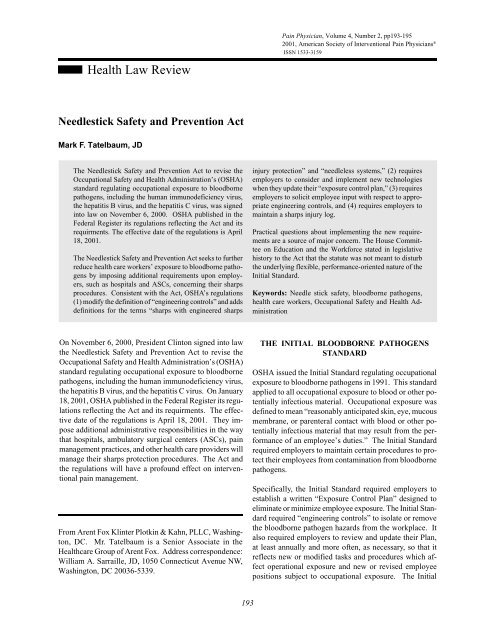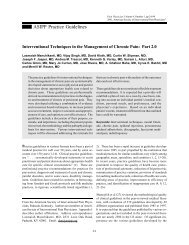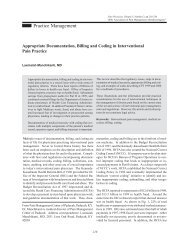Health Law Review - Pain Physician
Health Law Review - Pain Physician
Health Law Review - Pain Physician
Create successful ePaper yourself
Turn your PDF publications into a flip-book with our unique Google optimized e-Paper software.
<strong>Health</strong> <strong>Law</strong> <strong>Review</strong><br />
<strong>Pain</strong> <strong>Physician</strong>, Volume 4, Number 2, pp193-195<br />
2001, American Society of Interventional <strong>Pain</strong> <strong>Physician</strong>s ®<br />
ISSN 1533-3159<br />
Needlestick Safety and Prevention Act<br />
Mark F. Tatelbaum, JD<br />
The Needlestick Safety and Prevention Act to revise the<br />
Occupational Safety and <strong>Health</strong> Administration’s (OSHA)<br />
standard regulating occupational exposure to bloodborne<br />
pathogens, including the human immunodeficiency virus,<br />
the hepatitis B virus, and the hepatitis C virus, was signed<br />
into law on November 6, 2000. OSHA published in the<br />
Federal Register its regulations reflecting the Act and its<br />
requirments. The effective date of the regulations is April<br />
18, 2001.<br />
The Needlestick Safety and Prevention Act seeks to further<br />
reduce health care workers’ exposure to bloodborne pathogens<br />
by imposing additional requirements upon employers,<br />
such as hospitals and ASCs, concerning their sharps<br />
procedures. Consistent with the Act, OSHA’s regulations<br />
(1) modify the definition of “engineering controls” and adds<br />
definitions for the terms “sharps with engineered sharps<br />
injury protection” and “needleless systems,” (2) requires<br />
employers to consider and implement new technologies<br />
when they update their “exposure control plan,” (3) requires<br />
employers to solicit employee input with respect to appropriate<br />
engineering controls, and (4) requires employers to<br />
maintain a sharps injury log.<br />
Practical questions about implementing the new requirements<br />
are a source of major concern. The House Committee<br />
on Education and the Workforce stated in legislative<br />
history to the Act that the statute was not meant to disturb<br />
the underlying flexible, performance-oriented nature of the<br />
Initial Standard.<br />
Keywords: Needle stick safety, bloodborne pathogens,<br />
health care workers, Occupational Safety and <strong>Health</strong> Administration<br />
On November 6, 2000, President Clinton signed into law<br />
the Needlestick Safety and Prevention Act to revise the<br />
Occupational Safety and <strong>Health</strong> Administration’s (OSHA)<br />
standard regulating occupational exposure to bloodborne<br />
pathogens, including the human immunodeficiency virus,<br />
the hepatitis B virus, and the hepatitis C virus. On January<br />
18, 2001, OSHA published in the Federal Register its regulations<br />
reflecting the Act and its requirments. The effective<br />
date of the regulations is April 18, 2001. They impose<br />
additional administrative responsibilities in the way<br />
that hospitals, ambulatory surgical centers (ASCs), pain<br />
management practices, and other health care providers will<br />
manage their sharps protection procedures. The Act and<br />
the regulations will have a profound effect on interventional<br />
pain management.<br />
From Arent Fox Klinter Plotkin & Kahn, PLLC, Washington,<br />
DC. Mr. Tatelbaum is a Senior Associate in the<br />
<strong>Health</strong>care Group of Arent Fox. Address correspondence:<br />
William A. Sarraille, JD, 1050 Connecticut Avenue NW,<br />
Washington, DC 20036-5339.<br />
THE INITIAL BLOODBORNE PATHOGENS<br />
STANDARD<br />
OSHA issued the Initial Standard regulating occupational<br />
exposure to bloodborne pathogens in 1991. This standard<br />
applied to all occupational exposure to blood or other potentially<br />
infectious material. Occupational exposure was<br />
defined to mean “reasonably anticipated skin, eye, mucous<br />
membrane, or parenteral contact with blood or other potentially<br />
infectious material that may result from the performance<br />
of an employee’s duties.” The Initial Standard<br />
required employers to maintain certain procedures to protect<br />
their employees from contamination from bloodborne<br />
pathogens.<br />
Specifically, the Initial Standard required employers to<br />
establish a written “Exposure Control Plan” designed to<br />
eliminate or minimize employee exposure. The Initial Standard<br />
required “engineering controls” to isolate or remove<br />
the bloodborne pathogen hazards from the workplace. It<br />
also required employers to review and update their Plan,<br />
at least annually and more often, as necessary, so that it<br />
reflects new or modified tasks and procedures which affect<br />
operational exposure and new or revised employee<br />
positions subject to occupational exposure. The Initial<br />
193
Tatelbaum • Needlestick Safety and Prevention Act<br />
194<br />
Standard also required that employers maintain accurate<br />
medical records for each employee with occupational exposure.<br />
THE NEEDLESTICK SAFETY AND<br />
PREVENTION ACT<br />
The Needlestick Safety and Prevention Act seeks to further<br />
reduce health care workers’ exposure to bloodborne<br />
pathogens by imposing additional requirements upon employers,<br />
such as hospitals and ASCs, concerning their<br />
sharps procedures. Unless superceded by OSHA, the Act<br />
requires hospitals and ASCs, among others, to review and<br />
update their Plans to reflect changes in technology, consider<br />
and implement new technologies, solicit input from<br />
employees, and maintain a sharps injury log.<br />
THE REVISED STANDARD<br />
Consistent with the Act, OSHA’s regulations (1) modify<br />
the definition of “engineering controls” and adds definitions<br />
for the terms “sharps with engineered sharps injury<br />
protection” and “needleless systems,” (2) requires employers<br />
to consider and implement new technologies when they<br />
update their “exposure control plan,” (3) requires employers<br />
to solicit employee input with respect to appropriate<br />
engineering controls, and (4) requires employers to maintain<br />
a sharps injury log.<br />
Definitions<br />
In the final rule, OSHA modifies the definition of the term<br />
“engineering control” to clarify that it includes all control<br />
measures that isolate or remove a hazard from the workplace,<br />
such as “sharps with engineered sharps injury protections,”<br />
“needleless systems,” and all other medical devices<br />
designed to reduce the risk of percutaneous exposure<br />
to bloodborne pathogens. OSHA defines the term<br />
“sharps with engineered sharps injury protection” as a<br />
nonneedle sharp or needle device used for withdrawing<br />
body fluids, accessing a vein or artery, or administering<br />
medications or other fluids, with a built-in safety feature<br />
or mechanism that effectively reduces the risk of an exposure<br />
incident. OSHA defines the term “needleless systems”<br />
as a device that does not use needles for: (1) the collection<br />
of bodily fluids or withdrawal of body fluids after initial<br />
venous or arterial access is established; (2) administration<br />
of medication or fluids; or (3) any other procedure involving<br />
the potential for occupational exposure to bloodborne<br />
pathogens due to percuatneious injuries from contaminated<br />
sharps.<br />
Although OSHA states in the final rule that it does not<br />
intend these definitional changes to impose new requirements<br />
upon employers, such as hospitals and ASCs, they<br />
most certainly will require additional work. The definition<br />
changes will require employers to evaluate “sharps<br />
with engineered sharps injury protections,” “needleless<br />
systems,” and all other new medical devices that function<br />
as “engineering controls,” and may require employers to<br />
modify their Plans to incorporate these technologies.<br />
Consideration and Implementation of New Technology<br />
In this change, OSHA intends to impose new obligations<br />
on employers whose businesses affect interstate commerce,<br />
and whose employees are exposed to bloodborne pathogens.<br />
Affected employers will include hospitals, ASCs,<br />
and other health care facilities, as well as pain management<br />
practices and other physician practices in many circumstances.<br />
The regulation requires employers to account<br />
for innovations in technological developments that reduce<br />
the risk of exposure incidents. Employers must consider<br />
and implement “appropriate commercially available and<br />
effective safer medical devices” designed to eliminate or<br />
minimize occupation exposure, on at least an annual basis.<br />
The consideration undertaken must be documented.<br />
Unfortunately for hospitals and ASCs, the regulation does<br />
not offer much guidance as to how this consideration and<br />
implementation is to be conducted. The preamble to the<br />
regulation states only that a device will be considered to<br />
be “appropriate” if it will not jeopardize patient or employee<br />
safety, and is not medically contraindicated. OSHA<br />
further states that the determination of whether a device is<br />
“effective” should be based on a “reasonable judgment”<br />
that the device will make an exposure incident less likely.<br />
Nowhere, however, does OSHA indicate when it considers<br />
a device to be “available in the marketplace.” Nor,<br />
does OSHA state what it will consider to be a “safer medical<br />
device.”<br />
This lack of guidance presents a host of uncertainties in<br />
the efforts of hospitals and ASCs to comply with the final<br />
rule. For example, at what point can technology be said to<br />
have established that it eliminates or reduces exposure to<br />
bloodborne pathogens, such that it must be reflected in the<br />
Plan? When does a device become recognized as “safer?”<br />
Additionally, when is a device considered “effective?” Is<br />
effectiveness tied to Food and Drug Administration approval?<br />
Further, at what point does a device become “available<br />
in the marketplace?” How many units must be on<br />
sale for this standard to be met? What efforts must a hos-<br />
<strong>Pain</strong> <strong>Physician</strong> Vol. 4, No. 2, 2001
Tatelbaum • Needlestick Safety and Prevention Act<br />
195<br />
pital or ASC undertake to acquire the device? Is there a<br />
cost limit? If the hospital or ASC determines that the device<br />
is “safer,” “appropriate,” “commercially available,”<br />
and “effective,” and thus must implement the use of the<br />
device, from a practical perspective, how can it force a<br />
non-employee physician to use such device. If it does force<br />
the physician to use the device, e.g. through the medical<br />
staff bylaws, what is the increased liability risk to the facility<br />
for a bad outcome? For now, the best course will be for<br />
hospitals and ASCs to fully document their determinations,<br />
and the reasoning for them.<br />
Employee Input<br />
In addition to requiring that employers, such as hospitals<br />
and ASCs, consider and implement new technologies,<br />
OSHA also requires that they solicit the input of their employees.<br />
Specifically, OSHA will require employers to seek<br />
input from non-managerial employees who are responsible<br />
for direct patient care, and who may be potentially exposed<br />
to injuries from contaminated sharps. Employees must be<br />
asked to identify, evaluate, and select effective engineering<br />
and work practice controls. The solicitation for input<br />
must be documented in a employer’s Plan.<br />
There are no specific procedures as to how an employer<br />
must obtain employee input. A hospital or ASC is afforded<br />
the flexibility to solicit input in the manner in which it deems<br />
appropriate. The steps taken to solicit input must be reasonable,<br />
however. OSHA suggests what reasonable steps<br />
may be. OSHA states that a dental office employing two<br />
hygienists for instance, may choose to have periodic conversations<br />
with the hygienists. A large hospital would likely<br />
find that an effective process for soliciting employee input<br />
requires the implementation of more formal procedures<br />
OSHA adds. Methods for soliciting employee input may<br />
include involvement in informal problem-solving groups;<br />
participation in safety audits; worksite inspections; exposure<br />
incident investigations; participation in the evaluation<br />
of devices through pilot testing; and involvement in a safety<br />
and health committee properly constituted and operated in<br />
conformance with the National Labor Relations Board.<br />
Recordkeeping<br />
Not only must hospitals and ASC now consider and implement<br />
new technologies and solicit employee input in the<br />
identification, evaluation, and selection of controls, they<br />
must also under the final rule, maintain a sharps injury log<br />
for the purpose of identifying high risk areas and for evaluating<br />
devices. The log must be maintained so as to protect<br />
the confidentiality of the injured employee. The log must<br />
contain at a minimum: (1) the type and brand of the device<br />
involved in the incident, (2) the department or work area<br />
where the exposure incident occurred, and (3) an explanation<br />
of how the incident occurred.<br />
As with other requirements of the final rule, OSHA does<br />
not provide a sample or recommended format for the sharps<br />
log. OSHA states in the preamble, that employers are permitted<br />
to determine the format in which the log is maintained<br />
(e.g. paper or electronic), and may include information<br />
in addition to that required by the standard so long as<br />
the privacy of injured workers is protected. Although,<br />
hospitals and ASCs may use the OSHA 300 Log of Work-<br />
Related Injuries and Illnesses and the OSHA 301 Injury<br />
and Illness Incident Report to meet the sharps injury log<br />
requirements, provided that certain conditions are satisfied.<br />
CONCLUSION<br />
Congress and OSHA should be commended for acting to<br />
protect the country’s health care workers by reducing their<br />
exposure to bloodborne pathogens. Despite this worthwhile<br />
endeavor, however, practical questions about implementing<br />
the new requirements are a source of major concern.<br />
The House Committee on Education and the Workforce<br />
stated in legislative history to the Act that the statute was<br />
not meant to disturb the underlying flexible, performanceoriented<br />
nature of the Initial Standard. It also specifically<br />
stated that it “did not expect an OSHA inspector to substitute<br />
his judgment for that of the professional, clinical, and<br />
medical judgment of health care professionals responsible<br />
for patient safety.” Only time will tell if OSHA will honor<br />
this Congressional intent.<br />
The effective date of these revisions is April 18, 2001.<br />
Exposure Control Plans that are reviewed and updated on<br />
or after this date must incorporate these revised standards.<br />
The Act and the implementation regulations will begin to<br />
reshape practice in a matter of just a few weeks.<br />
<strong>Pain</strong> <strong>Physician</strong> Vol. 4, No. 2, 2001
















